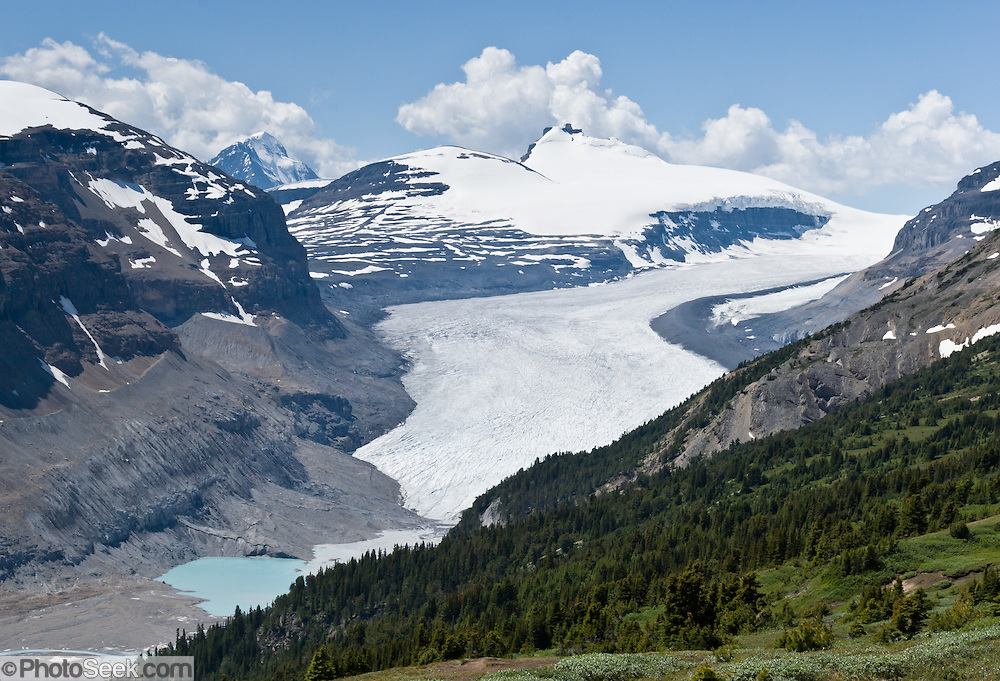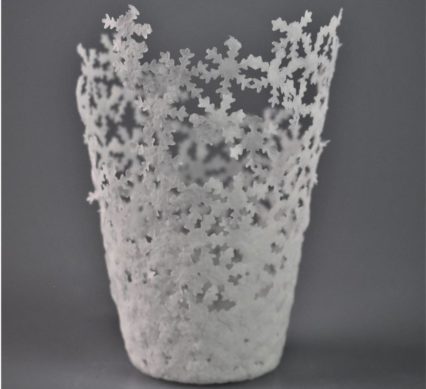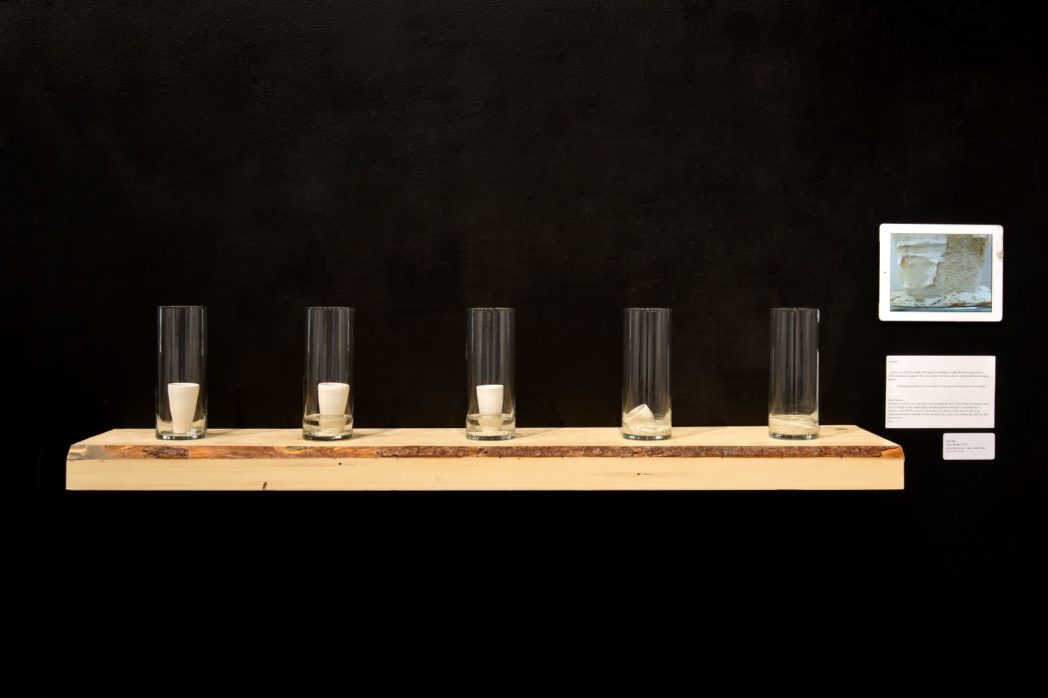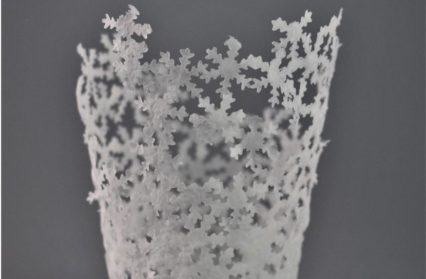Saskatchewan Glacier Series | Mary Ann Steggles profiles the work of Amy Snider, a ceramic artist who depicts the effect of climate change on Canadian glaciers using porcelain sculptures.
Amy Snider is currently an MFA student in Visual Art at the University of Regina. As a social activist and environmentalist, Amy has a deep respect for the Canadian prairies’ glaciers. Every year, until the pandemic restricted her movements in 2020, Amy made a pilgrimage to the Canadian Rockies to take in their beauty and majesty. She says that these trips give her the spiritual energy to survive the long dark Canadian winters. Amy is very concerned about the recession of glaciers globally and the retreat of the Columbia Icefield specifically. Through a series of ceramic cups titled Saskatchewan Glacier, Amy hopes that people will draw a link between the delicate objects she makes and what the total loss of the world’s glaciers will mean to all life on Earth.
The Columbia Icefield feeds a series of six interconnected glaciers formed at Mount Athabasca’s base on the continental divide in Alberta. The largest of the six glacial toes is the Saskatchewan Glacier. In 1960, the glacier-covered an area of over 400 metres. It had receded to 223 metres in 2005, losing almost half its size in forty-five years. For Amy, this is a huge problem. These glaciers sustain her spiritually and provide the domestic water supply for the people of Saskatchewan. Every time she takes a drink, the sheer magnitude of the climate crisis comes to mind.
Maude Barlow opens her book Boiling Point: Government Neglect, Corporate Abuse, and Canada’s Water Crisis with the following quote from David Schindler, a Canadian water scientist: ‘We are going to forget all about the economy when we run out of water’ (ix). Barlow does not mince any words in her criticism of all government levels who support corporations over our natural resources. In particular, she is critical of the fossil fuel industry and the lack of initiative in the climate crisis. When discussing glaciers, Barlow says that glaciers in Canada hold as much water as the country’s lakes and rivers and are a significant replenishment source for many watersheds. There are 17,000 glaciers in British Columbia, and research by the University of Northern British Columbia shows they are all melting (6-7).

The number of glaciers in the Canadian Rockies is declining rapidly. As much as a quarter of their mass has disappeared since 1990. The result of this depletion has been a series of droughts and shifting weather patterns across the Canadian prairies.
Barlow believes that we are facing irreversible change. She concludes:
The stage is being set for a drought on an unprecedented scale, for mass starvation and the migration of millions of water refugees leaving parched lands to look for water. All the justice and awareness in the world cannot stave off this future if the water is not there (3).

It is the writing of Barlow and others that has impacted the work of Amy Snider. Amy captures the fragility of the glaciers in her porcelain cup-shaped sculptures. They represent the state of the world’s ice fields in the face of climate change. Some melt, others disintegrate while pieces of others calve off. Calving is the term used for large chunks of ice breaking off the glacier caused by forwarding movement. The common name for these large chunks of ice is icebergs.
Saskatchewan Glacier (2019-20) is made of snowflake shapes barely touching one another to form the cup’s shape. The cup shape is a reminder that the water she drinks comes from a shrinking glacier directly related to human inaction. Since humans first began shaping clay and hardening these objects in their fire, the cup, like the bowl, symbolized nourishment, caring, warmth, security, and love. Amy’s cups symbolically contain the life-giving properties of water. Simultaneously, they are fragile like the glaciers, so delicate that a slight breeze will destroy the hundreds of tiny porcelain snowflakes that shape them.
In creating her snowflake cups, Amy uses porcelain, a clay known for its pure whiteness. The shapes of the delicate flakes visualize her concerns about climate change. Amy could have used several other materials, but she chose clay because it is geologically connected to the glaciers. The fragility of the paper-thin porcelain snowflakes serves as a metaphor for the ice fields’ ephemeral state. A small draft destroys them. Many do not survive the firing process, while others collapse during the installation. Photographs document their existence just as films and photos will, in the future, be the only evidence of the glaciers once they completely melt.

Another series, Calving, is a set of six cylindrical glass vases sitting on a shelf. Each vase houses a tiny unfired porcelain cup sitting in an inch of water. The number six is crucial because it represents the number of toes of the Columbia Glacier. Each is shown at a different stage of dissolving or calving. An iPad on the wall next to the shelf shows a macro-video of the process of one cup dissolving – with particles of clay coming off the cup and slowly making their way to the bottom of the vase.
Amy Snider is one of a growing number of activist artists whose art calls attention to the climate crisis’s urgency. Amy hopes that people will see her work, remember it, and take action. She believes that it is possible, just like Greta Thunberg, for all of the world’s people, to collectively change the damage that people have done over the past seventy-five to a hundred years. At the same time, as an artist, she is acutely aware of the impact that ceramics has on the environment. That begins with mining the material and its firing to transform soft, malleable clay into something that will last forever. She has rejected the firing of the material. She uses so little clay, recycling all of the abandoned buckets of clay at the university she can find that she is not concerned with mining the material. As a result, she works with unfired clay in a very sophisticated manner. Her pieces call attention to the importance of acting swiftly as both the glaciers and her ceramic installations disintegrate before us.
Mary Ann Steggles is a Canadian contributor with an interest in environmental reform and the intersection of art, particularly ceramics, and social activism. She recently retired from her position as Professor at the University of Manitoba to devote her time to writing full-time.












